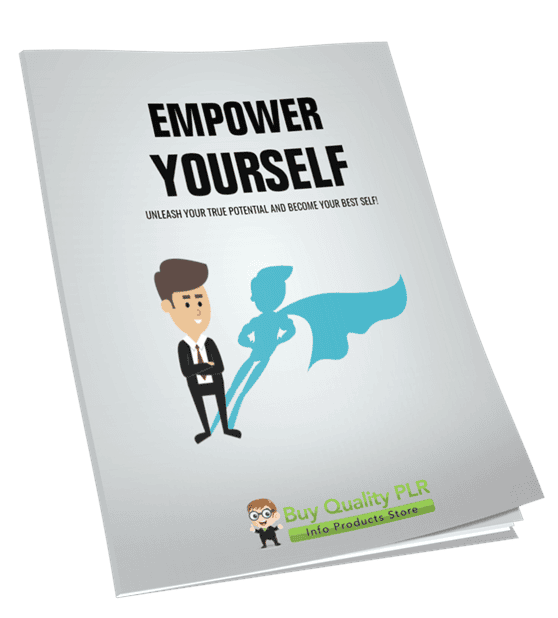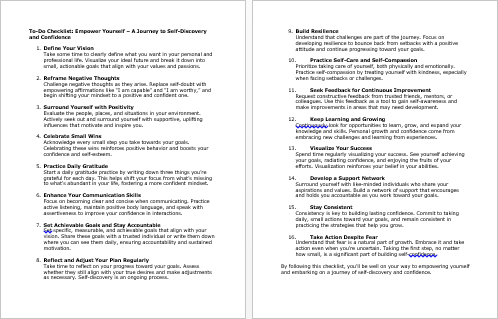
Empower Yourself PLR Course 26k Words
in PLR Checklists , PLR eBooks , PLR eCourses , PLR List Building Reports , Premium PLR , Premium PLR eBooks , Premium PLR Reports , Premium White Label Brandable PLR Coaching Courses , Private Label Rights Products , Self Improvement PLR , Self Improvement PLR EbooksChoose Your Desired Option(s)
has been added to your cart!
have been added to your cart!
#empoweryourself #plrcourse #personaldevelopment #selfgrowth #successmindset #empowermentcourse #lifeskills #transformyourlife #plrcontent #selfimprovement
Unleash Your True Potential and Become Your Best Self!
Take the first step toward self-discovery, confidence, and personal empowerment with the Empower Yourself PLR Course. This step-by-step guide is your ultimate resource for understanding your strengths, embracing your uniqueness, and achieving the life you’ve always envisioned.
Presenting…
Empower Yourself PLR Course 26k Words
What’s Inside the Empower Yourself Course?
Module 1: Uncovering Your True Self
Discover who you truly are and unlock your potential.
- Reflect on Your Values: Understand your core beliefs to guide your decisions and actions.
- Identify Your Strengths: Build confidence by recognizing what makes you exceptional.
- Explore Your Passions: Find what excites you and drives your purpose.
- Accept Your Imperfections: Embrace your flaws as part of your unique journey.
Module 2: Building Self-Awareness
Self-awareness is the foundation of growth and confidence.
- Practice Mindfulness: Stay present and gain clarity in your daily life.
- Keep a Journal: Reflect on your emotions and actions to uncover patterns.
- Listen to Your Inner Voice: Challenge self-limiting beliefs and create a positive mindset.
- Seek Feedback: Gain valuable insights from trusted friends or mentors.
Module 3: Cultivating a Positive Mindset
Learn how to shift your perspective and build unshakable confidence.
- Reframe Negative Thoughts: Replace doubt with empowering affirmations.
- Surround Yourself with Positivity: Choose uplifting influences for a healthier mindset.
- Celebrate Small Wins: Boost self-esteem by acknowledging your progress.
- Practice Gratitude Daily: Focus on abundance to nurture a positive outlook.
Module 4: Enhancing Your Communication Skills
Confident communication is a game-changer in personal and professional success.
- Be Clear and Concise: Deliver your message with confidence and clarity.
- Practice Active Listening: Build stronger relationships by giving others your full attention.
- Use Positive Body Language: Stand tall, maintain eye contact, and exude confidence.
- Speak with Assertiveness: Express your thoughts respectfully and effectively.
Module 5: Setting Empowering Goals
Turn your dreams into actionable plans and make them a reality.
- Define Your Vision: Create a clear picture of your ideal future.
- Break Goals into Steps: Develop actionable plans to achieve your objectives.
- Stay Accountable: Keep track of your progress and celebrate milestones.
- Reflect and Adjust: Continuously evolve as you grow and refine your goals.
Who Is This Course For?
- Individuals Seeking Growth: Unlock your full potential and gain clarity on your life’s purpose.
- Coaches and Trainers: Empower your clients with actionable strategies for confidence and self-discovery.
- Content Creators: Use this high-quality PLR content to build courses, workshops, or coaching programs.
What’s Included in the PLR Package?
- Empower Yourself Course (24,327 words): Comprehensive modules packed with actionable insights.
- Checklist (555 words): A quick guide to ensure nothing is overlooked.
- FAQs (1,165 words): Expert answers to common questions about self-empowerment.
- Sales Page (1,052 words): Ready-to-use copy to market the course effectively.
How to Use and Profit from This Course
- Sell It as a Standalone Product
Offer the course as a premium product priced between $47 and $97. - Bundle It with Other Courses
Combine it with related topics like personal growth, confidence building, or mindfulness to create a comprehensive package. - Create a Membership Program
Offer the course as part of a subscription service for ongoing income. - Host Workshops or Webinars
Use the course content to conduct live or pre-recorded training sessions, charging participants for access. - Use It as Lead Magnet Content
Offer excerpts as free downloads to grow your email list or attract new clients. - Rebrand and Resell
Customize the course to reflect your unique style and market it as your own.
Why Choose This PLR Course?
- Professionally Written: High-quality content designed for maximum impact.
- Highly Versatile: Use it to create courses, blogs, workshops, or coaching programs.
- Time-Saving: Ready-to-use material lets you start selling or using it immediately.
- Customizable: Edit, rebrand, and tailor the course to your audience.
Limited-Time Offer: Get the Empower Yourself PLR Course for Only $14.99!
Don’t miss this chance to own a premium course in the ever-growing self-development niche. Empower yourself—or your audience—with the tools to unlock confidence, clarity, and a life full of purpose.
has been added to your cart!
have been added to your cart!
Here A Sample of Empower Yourself PLR Course
Module 1: Uncovering Your True Self
In this first module, we’ll embark on an exciting journey to uncover your true identity and learn how to embrace who you truly are.
Step 1: Reflect on Your Values
Take some time to sit quietly and reflect on what truly matters to you. What are your core values? Understanding your values will serve as a compass for your journey toward self-discovery.
In this step, we’ll guide you through a reflective and intentional process to uncover the core principles that define your true self. This is not about quick answers—it’s about diving deeper to understand the essence of who you are and what drives your life. Let’s break this down into actionable steps.
Step 1.1: Create a Quiet and Intentional Space
The process of self-reflection requires an environment that supports focus and introspection. Find a peaceful location where you won’t be interrupted. This could be:
- A quiet room at home with soft, natural lighting.
- A serene spot in a park or garden.
- A cozy area in a library or a calm corner in a coffee shop.
Bring along a notebook, a pen, or a digital device to jot down your thoughts. Ensure that distractions like your phone or notifications are turned off.
Why this matters: A serene environment helps clear your mind and allows you to focus entirely on your inner thoughts, setting the tone for meaningful reflection.
Step 1.2: Explore Guiding Questions
Begin your reflection by asking yourself meaningful and thought-provoking questions. These will help you dig deep into what truly matters to you:
- What makes you feel most fulfilled or happy in life?
- Think about moments when you felt at peace or deeply satisfied. What were you doing, and why did it matter to you?
- Think about moments when you felt at peace or deeply satisfied. What were you doing, and why did it matter to you?
- What principles do you hold yourself accountable to?
- Consider the ethics and standards that guide your behavior and decisions. Do honesty, compassion, creativity, or responsibility play a role?
- Consider the ethics and standards that guide your behavior and decisions. Do honesty, compassion, creativity, or responsibility play a role?
- Who or what inspires you?
- Identify the people, causes, or ideas you admire. Why do they resonate with you?
- Identify the people, causes, or ideas you admire. Why do they resonate with you?
- What frustrates or disappoints you most?
- Sometimes, what we cannot tolerate reflects the values we hold most dear. For example, frustration with dishonesty may point to a strong value for integrity.
Take your time answering these questions. There’s no need to rush or force clarity.
Step 1.3: Capture Your Thoughts
Writing down your thoughts will help you organize and solidify your reflections. Use the following methods to articulate your ideas:
- Journaling: Write freely without worrying about structure. Let your thoughts flow naturally and revisit them later to identify recurring themes.
- Bullet Points: Create short, focused lists of key ideas or phrases that stand out to you.
- Mind Mapping: If you’re more visual, draw a mind map starting with “Values” in the center and branching out with related ideas.
Example:
- Moments of joy: Spending time with family, creating something meaningful.
- Core beliefs: Treating others with respect, taking responsibility for my actions.
- Inspirational figures: Nelson Mandela for his resilience, my grandmother for her kindness.
Why this matters: Writing transforms abstract thoughts into tangible insights, giving you a clearer view of what’s truly important.
Step 1.4: Identify and Define Your Core Values
Now, it’s time to analyze your notes and distill them into a set of 3–5 core values. These are the principles that consistently resonate with you and can serve as a compass in your life.
- Look for Patterns: Review your notes and highlight recurring words, themes, or emotions. For example, if you frequently mention fairness, equality, or empathy, this could point to a value of compassion.
- Narrow It Down: From your broader list, identify the values that resonate the most deeply. Examples of core values might include:
- Integrity
- Growth
- Family
- Creativity
- Freedom
- Define Your Values: Assign a personal meaning to each value. For instance:
- Integrity: Acting with honesty and standing by my principles, even when it’s difficult.
- Growth: Continuously seeking new knowledge and challenging myself to improve.
- Prioritize: Rank your values in order of importance, understanding that this is flexible and can evolve over time.
Step 1.5: Reflect and Revisit Regularly
Your values will become a guide for your decisions, relationships, and personal growth. However, self-discovery is an ongoing process, and your values may shift as you experience new things and grow.
- Set a reminder to revisit your values every few months.
- Reflect on how well your actions and choices align with these values.
- Adjust or redefine them if needed—your values are meant to grow with you.
Why this matters: Revisiting your values ensures they stay relevant and aligned with your evolving self.
Key Takeaway
Reflecting on your values is not a one-time exercise—it’s the foundation of self-awareness and personal growth. By understanding what truly matters to you, you gain a powerful compass to navigate life with purpose and confidence. This step sets the tone for your entire self-discovery journey. Take it seriously, but also enjoy the process of getting to know yourself better.
Step 2: Identify Your Strengths
What are you really good at? List down your strengths and achievements. By recognizing your strengths, you’ll build a foundation of confidence and positivity that will carry you through your self-discovery.
Understanding your strengths is a key step in building self-confidence and embracing your unique abilities. This process will help you appreciate your skills and accomplishments, empowering you to approach challenges with a positive mindset. Let’s break this down into clear, actionable steps.
Step 2.1: Reflect on Your Skills and Talents
The first step is to acknowledge what you’re naturally good at or have developed through experience. These might include hard skills, like coding or writing, or soft skills, like communication or problem-solving.
- Ask Yourself Questions:
- What activities come easily to me?
- What skills do others compliment me on?
- When do I feel the most capable and effective?
- Consider Past Successes: Think about times when you successfully tackled a challenge or received recognition for something you did well.
- Example: You might realize that leading a team project in school or work reflects your strength in leadership and organization.
- Example: You might realize that leading a team project in school or work reflects your strength in leadership and organization.
- Separate the Internal from the External: Identify the skills you know you’re good at internally, and those others consistently notice and praise. This dual perspective provides a fuller picture of your strengths.
Step 2.2: Create a Strengths and Achievements Inventory
Now, let’s make your strengths tangible by listing them out. This step will give you a clear, visual representation of your abilities.
- Divide Your Strengths into Categories:
- Professional Skills: These might include technical expertise, leadership, teamwork, or time management.
- Personal Strengths: These could be qualities like empathy, resilience, or adaptability.
- Hobbies or Talents: Think about creative or physical talents, such as painting, singing, or sports.
- Professional Skills: These might include technical expertise, leadership, teamwork, or time management.
- Write Down Your Achievements: Reflect on milestones or accomplishments you’re proud of, such as:
- Successfully completing a challenging project.
- Learning a new skill, like a language or musical instrument.
- Overcoming a personal challenge or adversity.
- Successfully completing a challenging project.
- Be Specific: Instead of general statements, include examples. For instance:
- Strength: Problem-solving.
- Achievement: Solved a supply chain issue at work that saved the company significant time and money.
Step 2.3: Seek Feedback from Trusted Sources
Sometimes, others see strengths in us that we overlook. Asking for input can help uncover hidden talents and give you a broader perspective.
- Reach Out to Trusted People: Ask family members, friends, colleagues, or mentors for their observations. Questions to ask:
- “What do you think I’m good at?”
- “What strengths do you think I bring to our relationship or workplace?”
- Compare Feedback with Your List: Look for patterns or new insights that align with or expand upon your existing list of strengths.
- Keep an Open Mind: Be willing to accept positive feedback—even if it feels uncomfortable. This is about building your confidence.
Step 2.4: Use Your Strengths as Building Blocks for Growth
Once you’ve identified your strengths, use them as a foundation to build self-confidence and guide your self-discovery journey.
- Celebrate Your Strengths: Take a moment to appreciate everything you’ve achieved and the skills you’ve developed. This celebration reinforces positivity and helps you internalize your abilities.
- Example: If you’re skilled at communication, remind yourself of a time you successfully resolved a conflict or led a productive meeting.
- Example: If you’re skilled at communication, remind yourself of a time you successfully resolved a conflict or led a productive meeting.
- Look for Opportunities to Apply Them: Use your strengths in new situations or challenges. For instance:
- If you’re good at public speaking, volunteer to present at work.
- If you excel at organizing, plan an event for your community.
- Identify Areas for Growth: Your strengths can highlight areas where you want to improve. For example, if you’re great at analysis but struggle with creativity, you can use your problem-solving skills to brainstorm creative solutions.
- Build Confidence Through Action: Every time you apply your strengths, you strengthen your belief in yourself. Confidence grows with practice.
Key Takeaway
Recognizing and celebrating your strengths is a powerful way to foster self-confidence and positivity. By identifying what you’re good at and acknowledging your achievements, you’re creating a solid foundation for self-discovery. This step reminds you that you already have the tools you need to thrive—you just need to recognize and use them.
Take your time with this process, and remember: your strengths are unique to you, and they are worth celebrating.
Step 3: Explore Your Passions
Think about what makes you excited, what you love doing in your spare time, and what you would pursue if there were no limitations. These passions are often the key to unlocking your true potential.
Exploring your passions is about uncovering the activities, interests, and causes that bring you joy and fulfillment. Passions fuel your energy and purpose, helping you align your life with what truly matters. Here’s a step-by-step guide to help you identify and embrace your passions.
Step 3.1: Reflect on Activities That Energize You
Start by identifying the activities that make you feel alive and engaged. These are often the things that come naturally and leave you feeling happy and accomplished.
- Ask Yourself Key Questions:
- What activities make you lose track of time?
- What do you look forward to doing in your free time?
- What challenges do you enjoy tackling?
- Consider Your Childhood Interests:
Reflect on what excited you as a child—whether it was drawing, building, storytelling, or exploring the outdoors. Childhood passions often reveal your authentic self before societal expectations took over. - Observe Patterns in Your Life:
Look for recurring themes in your hobbies or work. For example, if you’re often drawn to helping others, teaching, or solving problems, these might point to deeper passions.
Step 3.2: Create a Passion Inventory
A passion inventory is a list of activities, topics, or causes that excite and inspire you. This step helps you visualize your interests and organize your thoughts.
- Write Down What You Love Doing:
- Include hobbies, such as painting, playing an instrument, or gardening.
- Add professional interests, like designing, writing, or coding.
- Note causes you care about, such as environmental conservation or social justice.
- Include hobbies, such as painting, playing an instrument, or gardening.
- Think About Dreams Without Constraints:
- Ask yourself: “If money, time, or skills were not an issue, what would I do every day?”
- Write freely without judgment. For instance, you might want to travel the world, start a nonprofit, or write a book.
- Ask yourself: “If money, time, or skills were not an issue, what would I do every day?”
- Highlight What Makes You Happy:
- Mark the activities or interests that spark joy and energy. These are clues to your core passions.
Step 3.3: Experiment and Explore
Passions often become clearer through experience. Don’t be afraid to try new things or revisit old interests to discover what resonates with you.
- Dive Into New Experiences:
- Attend workshops, take a class, or join a local group in something that intrigues you.
- Example: If you’re curious about photography, start with a beginner’s course or explore online tutorials.
- Attend workshops, take a class, or join a local group in something that intrigues you.
- Revisit Forgotten Passions:
- Think about activities you once loved but stopped due to time or other priorities. Could you rekindle those interests now?
- Think about activities you once loved but stopped due to time or other priorities. Could you rekindle those interests now?
- Pay Attention to How You Feel:
- Notice your emotional response while exploring. Do you feel excited, fulfilled, or eager to continue? These feelings signal alignment with your passions.
- Notice your emotional response while exploring. Do you feel excited, fulfilled, or eager to continue? These feelings signal alignment with your passions.
- Keep an Open Mind:
- Remember that passions evolve. What excites you today might lead to unexpected interests tomorrow.
Step 3.4: Align Your Passions with Your Purpose
The final step is to connect your passions with your long-term goals and values. This alignment helps you move toward a more fulfilling life.
- Identify the Impact of Your Passions:
- Consider how your interests can make a difference for yourself and others.
- Example: If you love teaching, you might inspire others by sharing your knowledge.
- Integrate Passions Into Your Daily Life:
- Start small by dedicating time to your passions regularly, whether it’s an hour a week or a few minutes daily.
- Example: If writing is your passion, set aside 15 minutes each morning to journal or work on a story.
- Start small by dedicating time to your passions regularly, whether it’s an hour a week or a few minutes daily.
- Combine Passions and Professional Goals:
- Explore ways to turn your passions into a career or meaningful project.
- Example: If you love cooking, consider creating a food blog, hosting workshops, or experimenting with a catering business.
- Explore ways to turn your passions into a career or meaningful project.
- Let Your Passions Guide Your Decisions:
- Use your newfound clarity to choose opportunities that align with your interests and values. This creates a sense of purpose and satisfaction.
Key Takeaway
Exploring your passions is about reconnecting with what excites and inspires you. By reflecting, experimenting, and aligning your interests with your goals, you unlock your true potential and create a path to a fulfilling and meaningful life.
Passions are not just hobbies—they’re the compass pointing to your unique purpose. Embrace them, nurture them, and let them guide you toward a life that energizes and fulfills you.
Step 4: Accept Your Imperfections
We all have flaws, and that’s perfectly okay! In this step, we’ll work on embracing imperfections and seeing them as part of what makes you uniquely you. Imperfections are a sign of growth!
Accepting your imperfections is a transformative process that fosters self-love, resilience, and authenticity. Rather than striving for perfection, it’s about understanding that your flaws are part of your unique identity and recognizing that they don’t define your worth. This step-by-step guide will help you embrace your imperfections and view them as strengths in disguise.
Step 4.1: Shift Your Perspective on Imperfections
The way you perceive your flaws shapes how you feel about yourself. This step involves reframing your mindset and understanding that imperfections are natural and universal.
- Acknowledge the Universal Truth of Imperfection:
- No one is perfect, no matter how they appear on the surface. Everyone has challenges, insecurities, and things they wish to change about themselves.
- Reflect on people you admire. Even they have flaws that make them human and relatable.
- No one is perfect, no matter how they appear on the surface. Everyone has challenges, insecurities, and things they wish to change about themselves.
- Reframe Imperfections as Unique Traits:
- Instead of viewing your imperfections as problems, consider how they make you unique. For example, what you see as a flaw might actually set you apart in a positive way.
- Think about how your imperfections might contribute to your personal story or add depth to your character.
- Instead of viewing your imperfections as problems, consider how they make you unique. For example, what you see as a flaw might actually set you apart in a positive way.
- Learn from the Beauty of Imperfect Things:
- Consider examples from nature: a tree with irregular branches is still beautiful, and the cracks in a vase can tell a story of its history.
- Imperfections are often what give life depth and authenticity.
- Consider examples from nature: a tree with irregular branches is still beautiful, and the cracks in a vase can tell a story of its history.
Step 4.2: Practice Self-Compassion
Self-compassion is about treating yourself with kindness and understanding, especially when you feel inadequate or make mistakes.
- Replace Self-Criticism with Self-Kindness:
- When you notice self-critical thoughts, pause and ask yourself: “Would I speak this way to a friend?”
- Practice gentler self-talk by reminding yourself that making mistakes is part of being human.
- When you notice self-critical thoughts, pause and ask yourself: “Would I speak this way to a friend?”
- Acknowledge Your Efforts Over Outcomes:
- Celebrate your efforts rather than focusing solely on results. Doing your best is what truly matters.
- Example: If you didn’t perform perfectly at work, recognize the hard work you put into the task instead of fixating on small mistakes.
- Celebrate your efforts rather than focusing solely on results. Doing your best is what truly matters.
- Allow Yourself to Be Vulnerable:
- Accept that it’s okay to show your imperfections to others. Vulnerability can create deeper connections and foster mutual respect.
- Remember, people appreciate authenticity more than perfection.
- Accept that it’s okay to show your imperfections to others. Vulnerability can create deeper connections and foster mutual respect.
Step 4.3: See Imperfections as Opportunities for Growth
Your imperfections can be powerful teachers. When you embrace them, you open yourself to growth, self-awareness, and resilience.
- Identify Growth Opportunities in Your Flaws:
- Reflect on what your imperfections teach you. For instance, being disorganized might motivate you to develop better planning skills.
- Imperfections can often point to areas where you can improve, creating room for personal development.
- Reflect on what your imperfections teach you. For instance, being disorganized might motivate you to develop better planning skills.
- Embrace Failures as Lessons:
- Every mistake or shortcoming offers an opportunity to learn and grow.
- Example: If you’re not great at public speaking, treat each speaking opportunity as a chance to improve rather than an occasion for self-criticism.
- Every mistake or shortcoming offers an opportunity to learn and grow.
- Celebrate Progress Over Perfection:
- Focus on small victories and gradual improvements rather than striving for unrealistic ideals.
- Example: If you’re working on being more organized, celebrate each small step, like keeping your desk tidy for a week.
- Focus on small victories and gradual improvements rather than striving for unrealistic ideals.
Step 4.4: Embrace Your Authentic Self
The final step is to integrate your imperfections into your sense of self, recognizing that they are part of what makes you authentic and unique.
- Be Honest About Who You Are:
- Embrace your quirks, flaws, and vulnerabilities. They contribute to your individuality and make you relatable to others.
- Authenticity is about showing up as your true self, without hiding behind a facade of perfection.
- Embrace your quirks, flaws, and vulnerabilities. They contribute to your individuality and make you relatable to others.
- Surround Yourself with Supportive People:
- Spend time with people who accept you for who you are, flaws and all. Their support will reinforce your sense of self-worth.
- Avoid toxic relationships that make you feel inadequate or unworthy.
- Spend time with people who accept you for who you are, flaws and all. Their support will reinforce your sense of self-worth.
- Celebrate Your Entire Journey:
- Reflect on how far you’ve come, imperfections included. Your experiences—both successes and struggles—shape your story and give you strength.
- Appreciate the uniqueness that your imperfections bring to your life and the lives of those around you.
- Reflect on how far you’ve come, imperfections included. Your experiences—both successes and struggles—shape your story and give you strength.
Key Takeaway
Imperfections are not weaknesses; they are opportunities for growth and a reflection of your humanity. By shifting your perspective, practicing self-compassion, seeing flaws as growth opportunities, and embracing your authentic self, you can build greater self-acceptance and confidence.
This step is about learning to love yourself, not despite your imperfections, but because of them. They are what make you beautifully and uniquely you.
We’re also giving these extra bonuses
Empower Yourself – Checklist
Empower Yourself – FAQs

Empower Yourself – Salespage Content

Package Details:
Word Count: 24 327 Words
Number of Pages: 93
Empower Yourself – Bonus Content
Checklist
Word Count: 555 words
FAQs
Word Count: 1165 words
Salespage Content
Word Count: 1052 words
Total Word Count: 26 143 Words
Your PLR License Terms
PERMISSIONS: What Can You Do With These Materials?
Sell the content basically as it is (with some minor tweaks to make it “yours”).
If you are going to claim copyright to anything created with this content, then you must substantially change at 75% of the content to distinguish yourself from other licensees.
Break up the content into small portions to sell as individual reports for $10-$20 each.
Bundle the content with other existing content to create larger products for $47-$97 each.
Setup your own membership site with the content and generate monthly residual payments!
Take the content and convert it into a multiple-week “eclass” that you charge $297-$497 to access!
Use the content to create a “physical” product that you sell for premium prices!
Convert it to audios, videos, membership site content and more.
Excerpt and / or edit portions of the content to give away for free as blog posts, reports, etc. to use as lead magnets, incentives and more!
Create your own original product from it, set it up at a site and “flip” the site for megabucks!
RESTRICTIONS: What Can’t You Do With These Materials?
To protect the value of these products, you may not pass on the rights to your customers. This means that your customers may not have PLR rights or reprint / resell rights passed on to them.
You may not pass on any kind of licensing (PLR, reprint / resell, etc.) to ANY offer created from ANY PORTION OF this content that would allow additional people to sell or give away any portion of the content contained in this package.
You may not offer 100% commission to affiliates selling your version / copy of this product. The maximum affiliate commission you may pay out for offers created that include parts of this content is 75%.
You are not permitted to give the complete materials away in their current state for free – they must be sold. They must be excerpted and / or edited to be given away, unless otherwise noted. Example: You ARE permitted to excerpt portions of content for blog posts, lead magnets, etc.
You may not add this content to any part of an existing customer order that would not require them to make an additional purchase. (IE You cannot add it to a package, membership site, etc. that customers have ALREADY paid for.)
Share Now!













